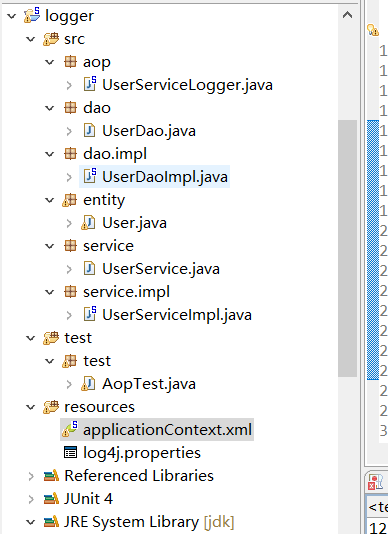溫馨提示×
您好,登錄后才能下訂單哦!
點擊 登錄注冊 即表示同意《億速云用戶服務條款》
您好,登錄后才能下訂單哦!
小編給大家分享一下Spring框架如何實現AOP添加日志記錄功能,相信大部分人都還不怎么了解,因此分享這篇文章給大家參考一下,希望大家閱讀完這篇文章后大有收獲,下面讓我們一起去了解一下吧!
需求,在調用業務方法的時候,在被調用的業務方法的前面和后面添加上日志記錄功能
整體架構:

日志處理類:
package aop;
import java.util.Arrays;
import org.apache.log4j.Logger;
import org.aspectj.lang.JoinPoint;
//日志處理類 增強處理類-日志
public class UserServiceLogger {
private Logger logger = Logger.getLogger(UserServiceLogger.class);
// 前置增強
public void before(JoinPoint joinPoint) {
logger.info("調用" + joinPoint.getTarget() + "的"
+ joinPoint.getSignature() + "方法,方法參數是:"
+ Arrays.toString(joinPoint.getArgs()));
}
// 后置增強
public void afterReturning(JoinPoint joinPoint,Object result) {
logger.info("調用" + joinPoint.getTarget() + "的"
+ joinPoint.getSignature() + "方法,方法的返回值是:"
+result);
}
}下面是一個三層架構模式:
package dao;
import entity.User;
/**
* 增加DAO接口,定義了所需的持久化方法
*/
public interface UserDao {
public void save(User user);
}package dao.impl;
import dao.UserDao;
import entity.User;
/**
* 用戶DAO類,實現IDao接口,負責User類的持久化操作
*/
public class UserDaoImpl implements UserDao {
public void save(User user) {
// 這里并未實現完整的數據庫操作,僅為說明問題
System.out.println("保存用戶信息到數據庫");
}
}package entity;
/**
* 用戶實體類
*/
public class User implements java.io.Serializable {
private Integer id; // 用戶ID
private String username; // 用戶名
private String password; // 密碼
private String email; // 電子郵件
// getter & setter
public Integer getId() {
return id;
}
public void setId(Integer id) {
this.id = id;
}
public String getUsername() {
return username;
}
public void setUsername(String username) {
this.username = username;
}
public String getPassword() {
return password;
}
public void setPassword(String password) {
this.password = password;
}
public String getEmail() {
return email;
}
public void setEmail(String email) {
this.email = email;
}
}package service;
import entity.User;
/**
* 用戶業務接口,定義了所需的業務方法
*/
public interface UserService {
public void addNewUser(User user);
}package service.impl;
import service.UserService;
import dao.UserDao;
import entity.User;
/**
* 用戶業務類,實現對User功能的業務管理
*/
public class UserServiceImpl implements UserService {
// 聲明接口類型的引用,和具體實現類解耦合
private UserDao dao;
// dao 屬性的setter訪問器,會被Spring調用,實現設值注入
public void setDao(UserDao dao) {
this.dao = dao;
}
public void addNewUser(User user) {
// 調用用戶DAO的方法保存用戶信息
dao.save(user);
}
}編寫單元測試方法:
package test;
import org.junit.Test;
import org.springframework.context.ApplicationContext;
import org.springframework.context.support.ClassPathXmlApplicationContext;
import service.UserService;
import service.impl.UserServiceImpl;
import entity.User;
public class AopTest {
@Test
public void aopTest() {
ApplicationContext ctx = new ClassPathXmlApplicationContext("applicationContext.xml");
UserService service = (UserService) ctx.getBean("service");
User user = new User();
user.setId(1);
user.setUsername("test");
user.setPassword("123456");
user.setEmail("test@xxx.com");
service.addNewUser(user);
}
}applicationContext.xml核心配置文件:
<?xml version="1.0" encoding="UTF-8"?> <beans xmlns="http://www.springframework.org/schema/beans" xmlns:xsi="http://www.w3.org/2001/XMLSchema-instance" xmlns:aop="http://www.springframework.org/schema/aop" xsi:schemaLocation="http://www.springframework.org/schema/beans http://www.springframework.org/schema/beans/spring-beans-3.2.xsd http://www.springframework.org/schema/aop http://www.springframework.org/schema/aop/spring-aop-3.2.xsd"> <bean id="dao" class="dao.impl.UserDaoImpl"></bean> <bean id="service" class="service.impl.UserServiceImpl"> <property name="dao" ref="dao"></property> </bean> <!-- 聲明增強方法所在的Bean --> <bean id="theLogger" class="aop.UserServiceLogger"></bean> <!-- 配置切面 --> <aop:config> <!-- 定義切入點 --> <aop:pointcut id="pointcut" expression="execution(public void addNewUser(entity.User))" /> <!-- 引用包含增強方法的Bean --> <aop:aspect ref="theLogger"> <!-- 將before()方法定義為前置增強并引用pointcut切入點 --> <aop:before method="before" pointcut-ref="pointcut"></aop:before> <!-- 將afterReturning()方法定義為后置增強并引用pointcut切入點 --> <!-- 通過returning屬性指定為名為result的參數注入返回值 --> <aop:after-returning method="afterReturning" pointcut-ref="pointcut" returning="result" /> </aop:aspect> </aop:config> </beans>
運行結果:
12-29 15:13:06[INFO]org.springframework.context.support.ClassPathXmlApplicationContext -Refreshing org.springframework.context.support.ClassPathXmlApplicationContext@2db0f6b2: startup date [Sun Dec 29 15:13:06 CST 2019]; root of context hierarchy 12-29 15:13:06[INFO]org.springframework.beans.factory.xml.XmlBeanDefinitionReader -Loading XML bean definitions from class path resource [applicationContext.xml] 12-29 15:13:06[INFO]org.springframework.beans.factory.support.DefaultListableBeanFactory -Pre-instantiating singletons in org.springframework.beans.factory.support.DefaultListableBeanFactory@3701eaf6: defining beans [userDao,service,theLogger,org.springframework.aop.config.internalAutoProxyCreator,pointcut,org.springframework.aop.aspectj.AspectJPointcutAdvisor#0,org.springframework.aop.aspectj.AspectJPointcutAdvisor#1]; root of factory hierarchy 12-29 15:13:06[INFO]aop.UserServiceLogger -調用service.impl.UserServiceImpl@3c130745的void service.UserService.addNewUser(User)方法,方法參數是:[entity.User@2e4b8173] 保存用戶信息到數據庫 12-29 15:13:06[INFO]aop.UserServiceLogger -調用service.impl.UserServiceImpl@3c130745的void service.UserService.addNewUser(User)方法,方法的返回值是:null
以上是“Spring框架如何實現AOP添加日志記錄功能”這篇文章的所有內容,感謝各位的閱讀!相信大家都有了一定的了解,希望分享的內容對大家有所幫助,如果還想學習更多知識,歡迎關注億速云行業資訊頻道!
免責聲明:本站發布的內容(圖片、視頻和文字)以原創、轉載和分享為主,文章觀點不代表本網站立場,如果涉及侵權請聯系站長郵箱:is@yisu.com進行舉報,并提供相關證據,一經查實,將立刻刪除涉嫌侵權內容。